Performance Investigation Based on Vital Factors of Agricultural Feeder Supported by Solar Photovoltaic Power Plant †
Abstract
:1. Introduction
2. Role of PV in the Agricultural Sector of India
3. A Detailed Case Study
3.1. Need for Feeder Separation
3.2. Load Details
4. Performance Analysis of the Plant
- 1 December 2018: The plant was under shutdown for the duration of 01:44 h due to a technical issue observed in the Vacuum Circuit Breaker (VCB) spring charging AC motor connected to the incomer side of the substation.
- 17 December 2018: Cloudy weather throughout the day and 33 kV supply failure from 220 kV Yavatmal substation for the duration of 00:08 h.
- 18 December 2018: Cloudy weather and electricity failure for the duration of 00:25 h.
- 30 December 2018: Electricity failure for the duration of 00:20 h and breakdown for the time of 05:45 h.
- Grid Dependency: Grid Dependency is the ratio of power taken from grid by AG load to the total power consumed by AG load.
- PV Penetration: PV Penetration is the ratio of peak PV capacity to the peak load on the feeder.
- PV Contribution: PV Contribution is the ratio of total PV power supplied to the feeder to the total load demand on the feeder.
- CUF: Capacity Utilization Factor (CUF) is the ratio of total export to the installed capacity of the plant.
4.1. Grid Dependency
4.2. PV Penetration
4.3. PV Contribution
4.4. Capacity Utilization Factor
5. Conclusions
Author Contributions
Funding
Institutional Review Board Statement
Informed Consent Statement
Data Availability Statement
Acknowledgments
Conflicts of Interest
References
- Anas, R.; Agrawal, S.; Jain, A. Powering Agriculture in India: Strategies to Boost Components A & C under PM-KUSUM Scheme; Council on Energy, Environment and Water (CEEW): New Delhi, India, 2021. [Google Scholar]
- Patel, R.B.; Patel, R.D. Smart Energy Management for the Grid Connected Solar Agricultural Prosumers and Consumers; Metering India—Leema: New Delhi, India, 2019. [Google Scholar]
- Moharil, R.M.; Kulkarni, P.S. A case study of solar photovoltaic power system at Sagardeep Island India. Renew. Sustain. Energy Rev. 2009, 13, 673–681. [Google Scholar] [CrossRef]
- Eltawil, M.A.; Zhao, Z. Grid-connected photovoltaic power systems: Technical and potential problems—A review. Renew. Sustain. Energy Rev. 2010, 14, 112–129. [Google Scholar] [CrossRef]
- Coddington, M.H.; Baca, D.; Kroposki, B.D.; Basso, T. Deploying high penetration photovoltaic systems–A case study. In Proceedings of the 2011 37th IEEE Photovoltaic Specialists Conference, Seattle, WA, USA, 19–24 June 2011; pp. 002594–002599. [Google Scholar]
- Khare, V.; Nema, S.; Baredar, P. Status of solar wind renewable energy in India. Renew. Sustain. Energy Rev. 2013, 27, 1–10. [Google Scholar] [CrossRef] [Green Version]
- Kordkheili, R.; Bak-Jensen, B.; Pillai, J.R.; Mahat, P. Determining maximum photovoltaic penetration in a distribution grid considering grid operation limits. In Proceedings of the 2014 IEEE PES General Meeting|Conference & Exposition, National Harbor, MD, USA, 27–31 July 2014. [Google Scholar]
- Chidurala, A.; Saha, T.; Mithulananthan, N. Field investigation of voltage quality issues in distribution network with PV penetration. In Proceedings of the 2015 IEEE PES Asia-Pacific Power and Energy Engineering Conference (APPEEC), Brisbane, Australia, 15–18 November 2015. [Google Scholar]
- Lolla, S.; Roy, S.; Chowdhury, S. Wind and Solar Energy Resources in India. Energy Procedia 2015, 76, 187–192. [Google Scholar] [CrossRef] [Green Version]
- Karimi, M.; Mokhlis, H.; Naidu, K.; Uddin, S.; Bakar, A.H. Photovoltaic penetration issues and impacts in distribution network–A review. Renew. Sustain. Energy Rev. 2016, 53, 594–605. [Google Scholar] [CrossRef]
- Uzum, B.; Onen, A.; Hasanien, H.M.; Muyeen, S.M. Rooftop Solar PV Penetration Impacts on Distribution Network and Further Growth Factors—A Comprehensive Review. Electronics 2021, 10, 55. [Google Scholar] [CrossRef]
- Sarraf, A.; Agarwal, S.; Sharma, D. Performance of 1 MW photovoltaic system in Rajasthan: A case study. In Proceedings of the 2016 IEEE 7th Power India International Conference (PIICON), Bikaner, India, 25–27 November 2016. [Google Scholar]
- Sreedevi, J.; Ashwin, N.; Naini Raju, M. A study on grid connected PV system. In Proceedings of the 2016 National Power Systems Conference (NPSC), Bhubaneswar, India, 19–21 December 2016. [Google Scholar]
- Aziz, T.; Ketjoy, N. PV penetration limits in low voltage networks and voltage variations. IEEE Access 2017, 5, 16784–16792. [Google Scholar] [CrossRef]
- Badulescu, N.; Triștiu, I. Integration of photovoltaics in a sustainable irrigation system for agricultural purposes. In Proceedings of the 2017 International Conference on ENERGY and ENVIRONMENT (CIEM), Bucharest, Romania, 19–20 October 2017; pp. 36–40. [Google Scholar]
- Maisanam, A.; Biswas, A.; Sharma, K. Solar power potential of North-east India–A case study for Silchar. AIP Conf. Proc. 2018, 1952, 020002. [Google Scholar]
- Chathurangi, D.; Jayatunga, U.; Rathnayake, M.; Perera, S. Potential power quality impacts on LV distribution networks with high penetration levels of solar PV. In Proceedings of the 2018 18th International Conference on Harmonics and Quality of Power (ICHQP), Ljubljana, Slovenia, 13–16 May 2018. [Google Scholar]
- Oliveira, R.; Amaral, F.; Oliveira, F. Solar generation impact on voltage of rural power distribution networks: A case study. In Proceedings of the 2018 Simposio Brasileiro de Sistemas Eletricos (SBSE), Niteroi, Brazil, 12–16 May 2018. [Google Scholar]
- Hasarmani, T.; Holmukhe, R.; Tamke, S. Performance analysis of grid interfaced photovoltaic systems for reliable agri-microgrids using PVsyst. In Proceedings of the 2019 International Conference on Information and Communications Technology (ICOIACT), Yogyakarta, Indonesia, 24–25 July 2019; pp. 894–898. [Google Scholar]
- Alboaouh, K.A.; Salman Mohagheghi, S. Impact of rooftop Photovoltaics on the distribution system. J. Renew. Energy 2020, 2020, 4831434. [Google Scholar] [CrossRef]
- Akshay Urja, A. Bi-Monthly Newsletter of the Ministry of New and Renewable Energy, Government of India. August 2018; Volume 12, pp. 1–52. Available online: https://mnre.gov.in/img/documents/uploads/670406a017f54c9386fcde911ee5abe6.pdf (accessed on 4 December 2021).
- Mahanta, K.; Burman1, D.; Sarangi1, S.; Mandal1, U.; Maji1, B.; Mandal, S.; Digar, S.; Mainuddin, M. Drip Irrigation for Reducing Soil Salinity and Increasing Cropping Intensity: Case Studies in Indian Sundarbans. J. Indian Soc. Coast. Agric. Res. 2019, 37, 64–71. [Google Scholar]
- Ministry of New and Renewable Energy. ‘Vikaspedia’ Online Information Guide Launched by the Government of India. PM KUSUM Scheme; MNRE: New Delhi, India, 2019. Available online: https://vikaspedia.in/energy/policy-support/renewable-energy-1/solar-energy/pm-kusum-scheme (accessed on 10 May 2021).
- Best Practices on e-Platform of CEA; MSEDCL: Mumbai, India, 2012; Available online: https://cea.nic.in/wp-content/uploads/2020/04/mah.pdf (accessed on 18 May 2021).
- Central Electricity Authority (Technical Standards for Connectivity to the Grid) Amendment Regulations. 2013. Available online: https://cea.nic.in/wp-content/uploads/2020/02/grid_connectivity_12112013.pdf (accessed on 10 May 2021).
- Moharil, R.; Kulkarni, P. Reliability analysis of solar photovoltaic system using hourly mean solar radiation data. Sol. Energy 2010, 84, 691–702. [Google Scholar] [CrossRef]
- Verschueren, T.; Mets, K.; Meersman, B.; Strobbe, M.; Evelder, C.; Vandevelde, L. Assessment and mitigation of voltage violations by solar panels in a residential distribution grid. In Proceedings of the 2011 IEEE International Conference on Smart Grid Communications (SmartGridComm), Brussels, Belgium, 17–20 October 2011. [Google Scholar]
- Ellis, A. Grid Operations and High Penetration PV; National Renewable Energy Laboratory (NREL): Golden, CO, USA; U.S. Department of Energy: Washington, DC, USA, 2010. Available online: https://www1.eere.energy.gov/solar/pdfs/2010ulw_ellis.pdf (accessed on 30 November 2021).
- Impact of Photovoltaic Generation on Power Quality in Urban Areas with High PV Population (Results from Monitoring Campaigns). 2008. Available online: http://www.pvupscale.org/IMG/pdf/WP4_D4-3_public_v1c.pdf (accessed on 5 December 2021).
- Padole, N.; Moharil, R.; Munshi, A. Solar Photovoltaic (SPV) Power Plant Connected Agricultural Feeder Performance Analysis. In Proceedings of the 2021 International Conference on Electrical, Computer, Communications and Mechatronics Engineering (ICECCME), Mauritius, Mauritius, 7–8 October 2021; pp. 1–7. [Google Scholar]
- Shiva Kumar, B.; Sudhakar, K. Performance evaluation of 10 MW grid connected solar photovoltaic power plant in India. Energy Rep. 2015, 1, 184–192. [Google Scholar] [CrossRef] [Green Version]
- Central Electricity Regulatory Commission. Performance of Solar Power Plants in India; Central Electricity Regulatory Commission: New Delhi, India, 2011. Available online: https://cercind.gov.in/2011/Whats-New/PERFORMANCE%20OF%20SOLAR%20POWER%20PLANTS.pdf (accessed on 30 November 2021).


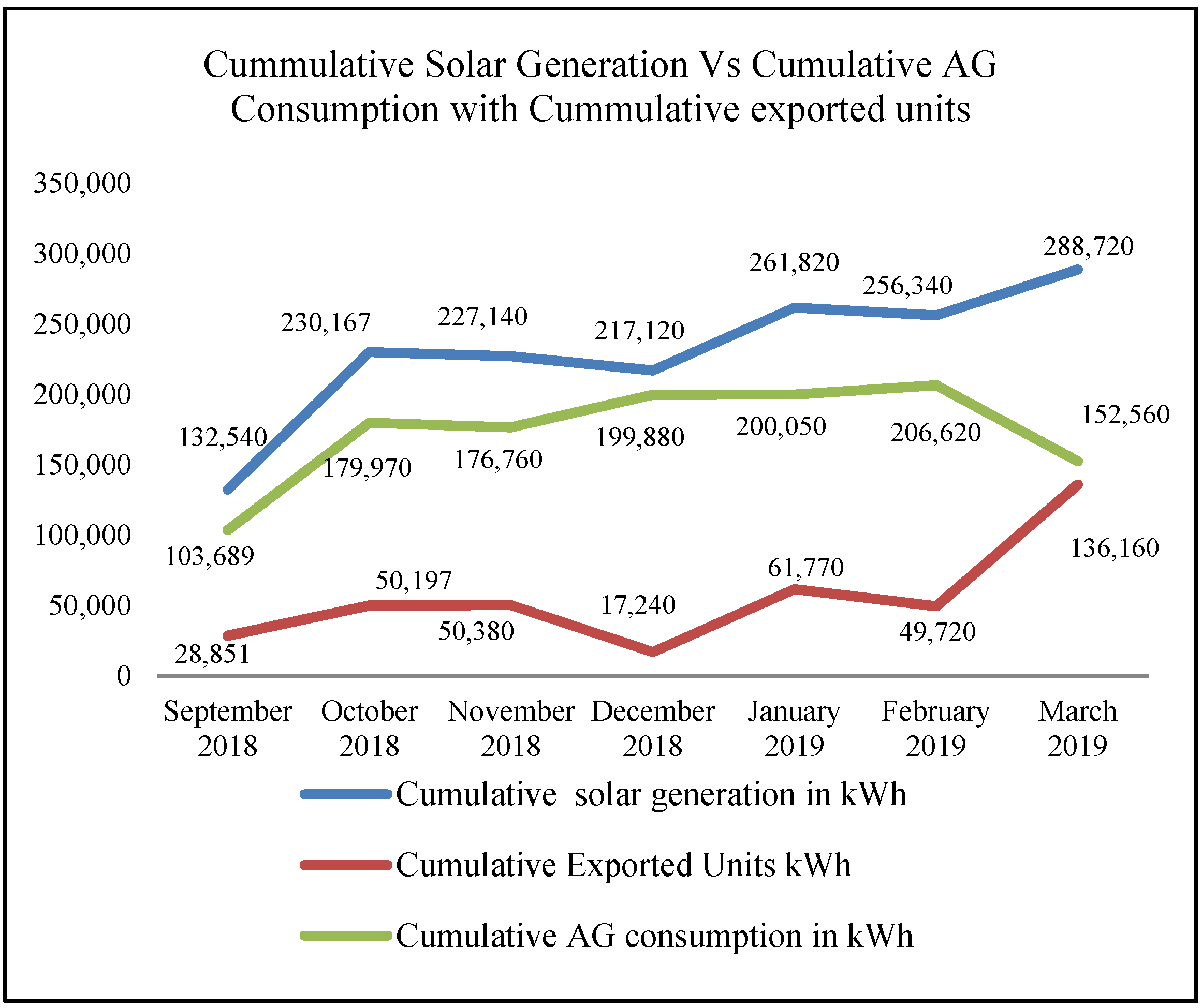
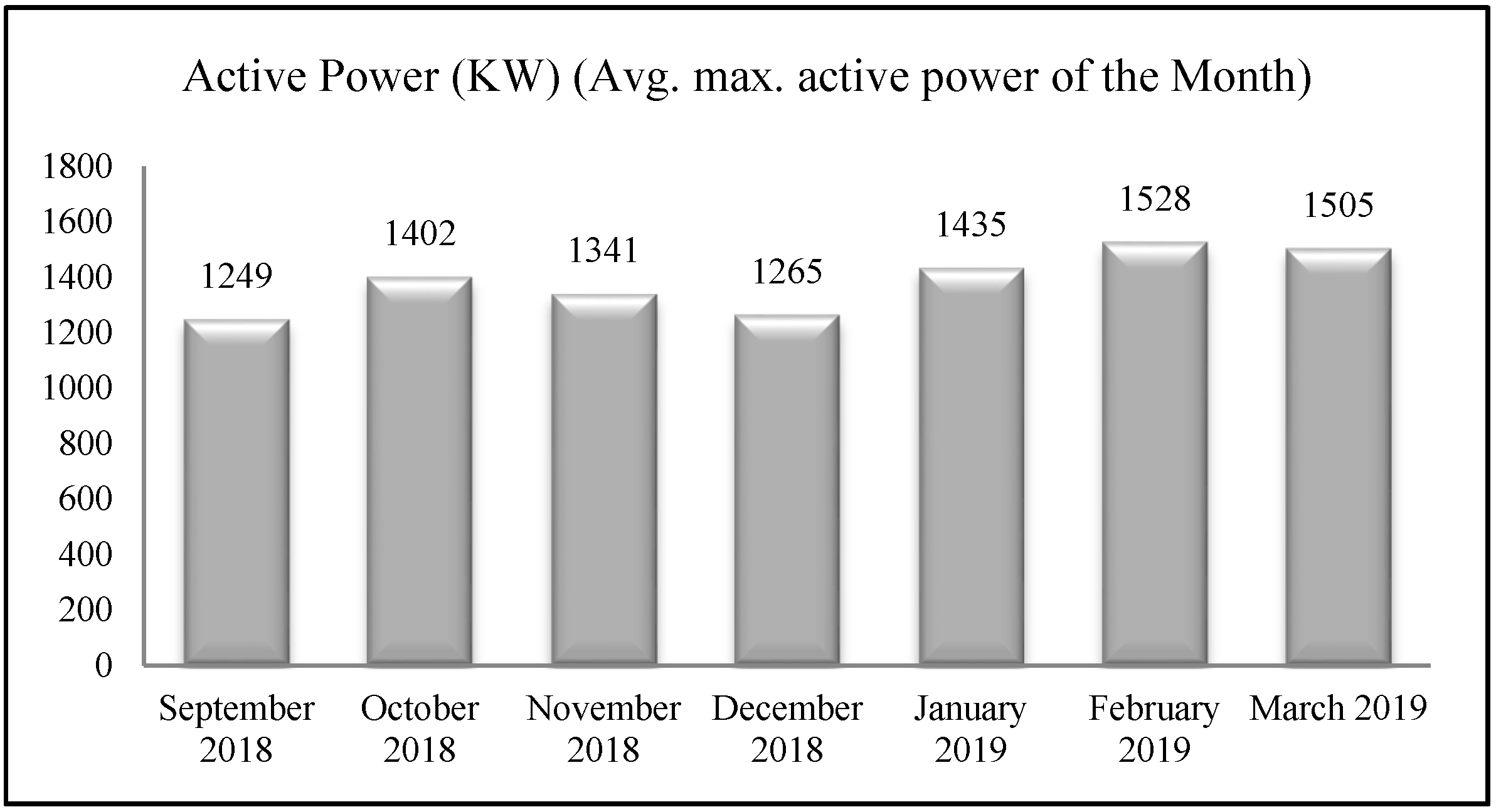
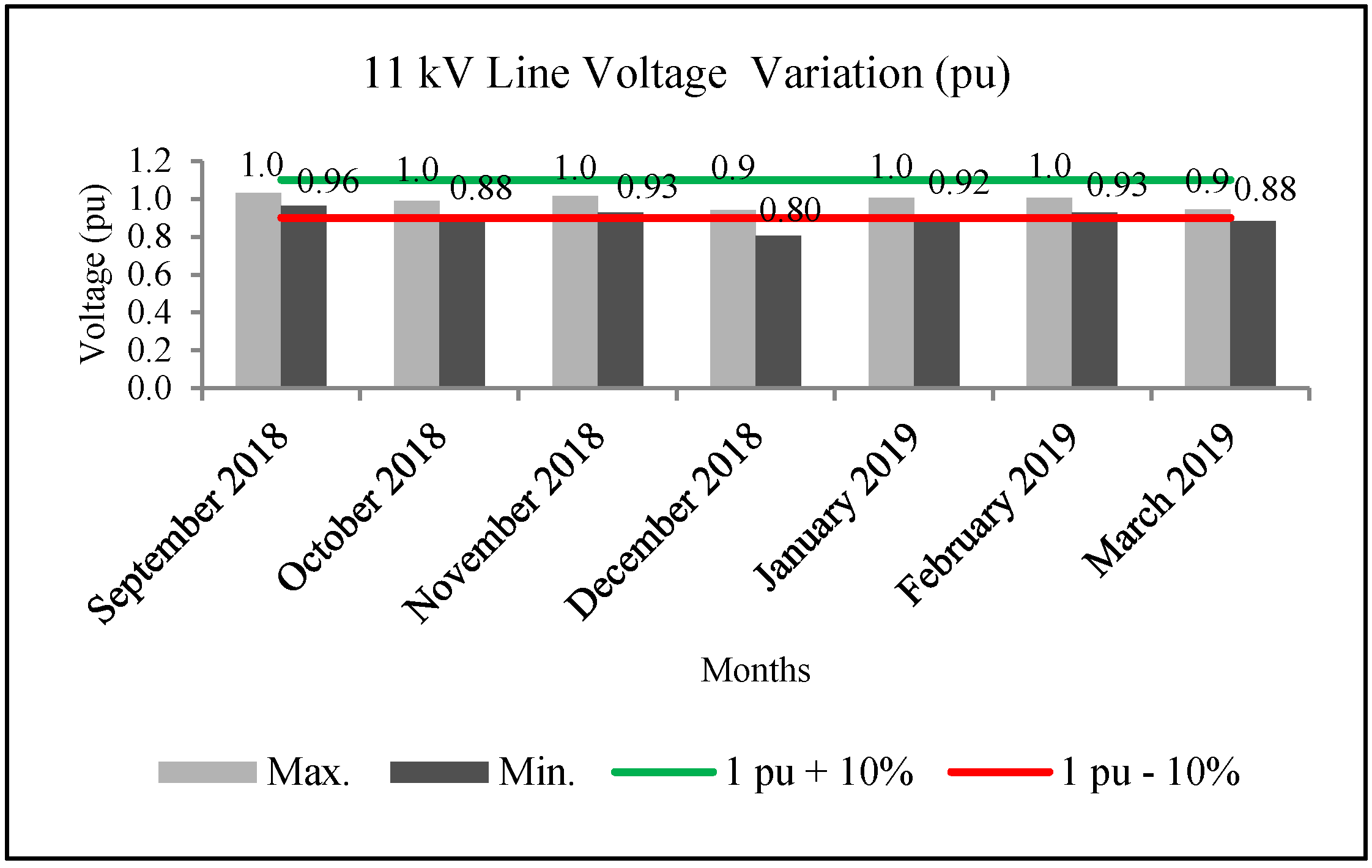
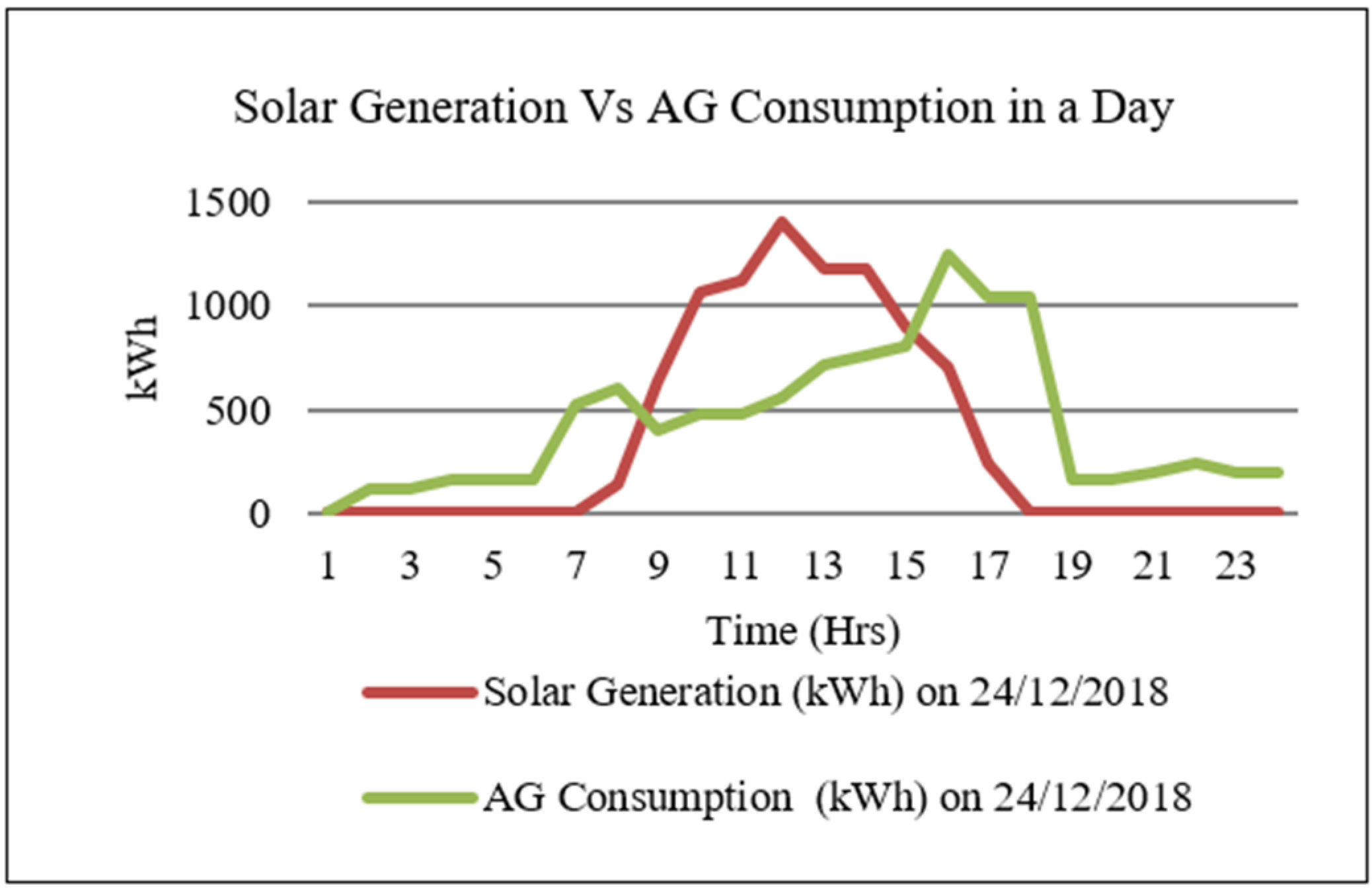
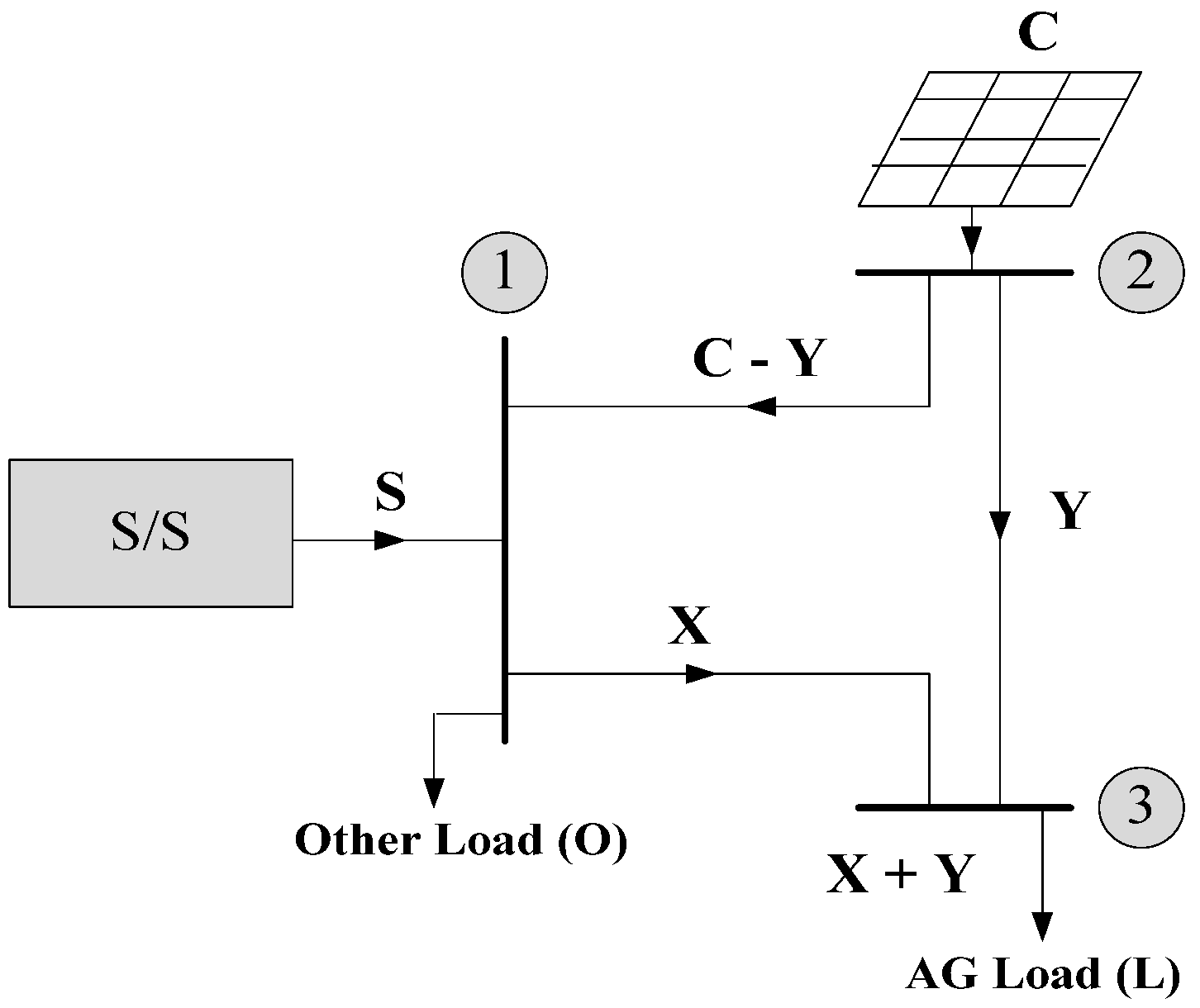
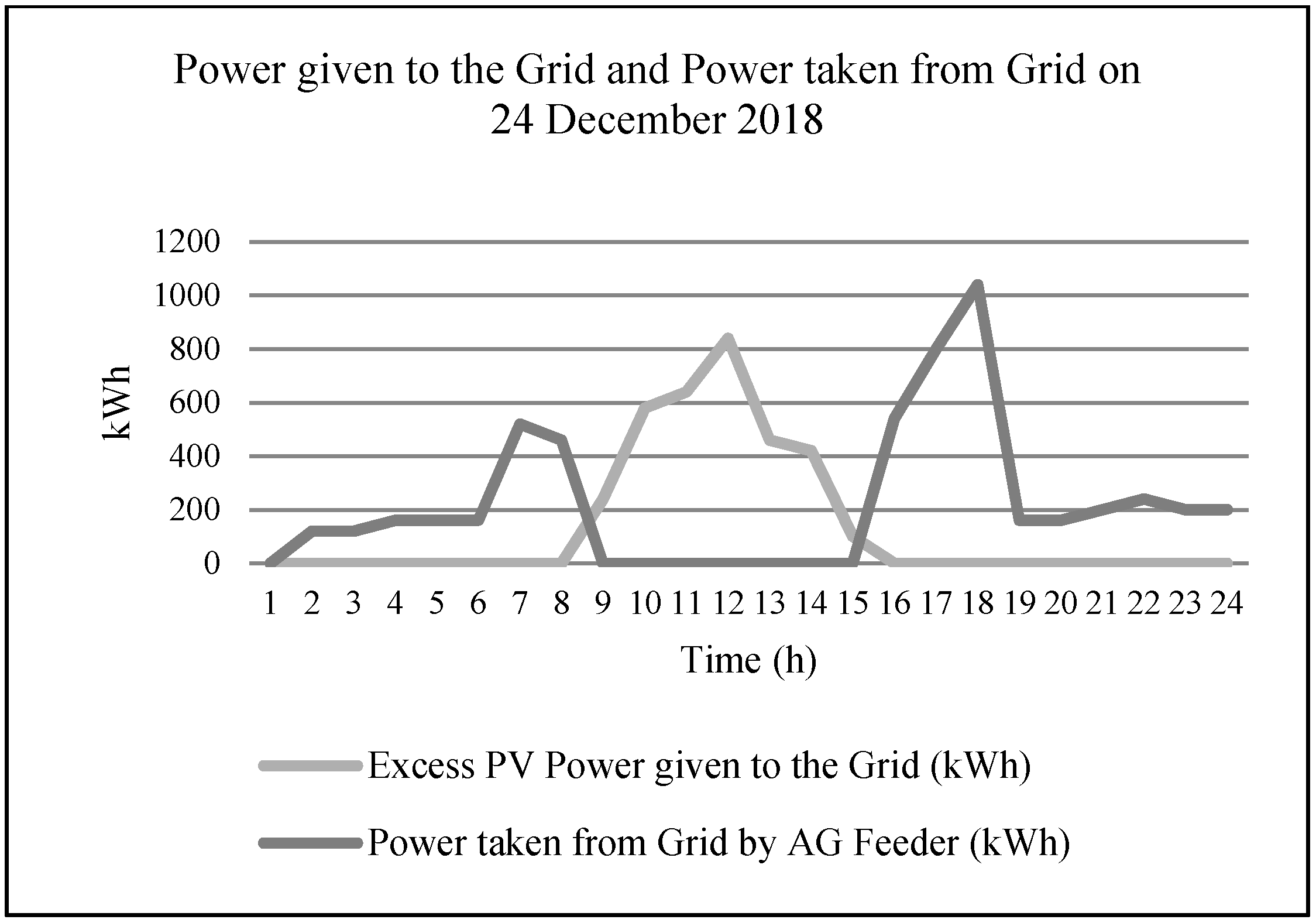
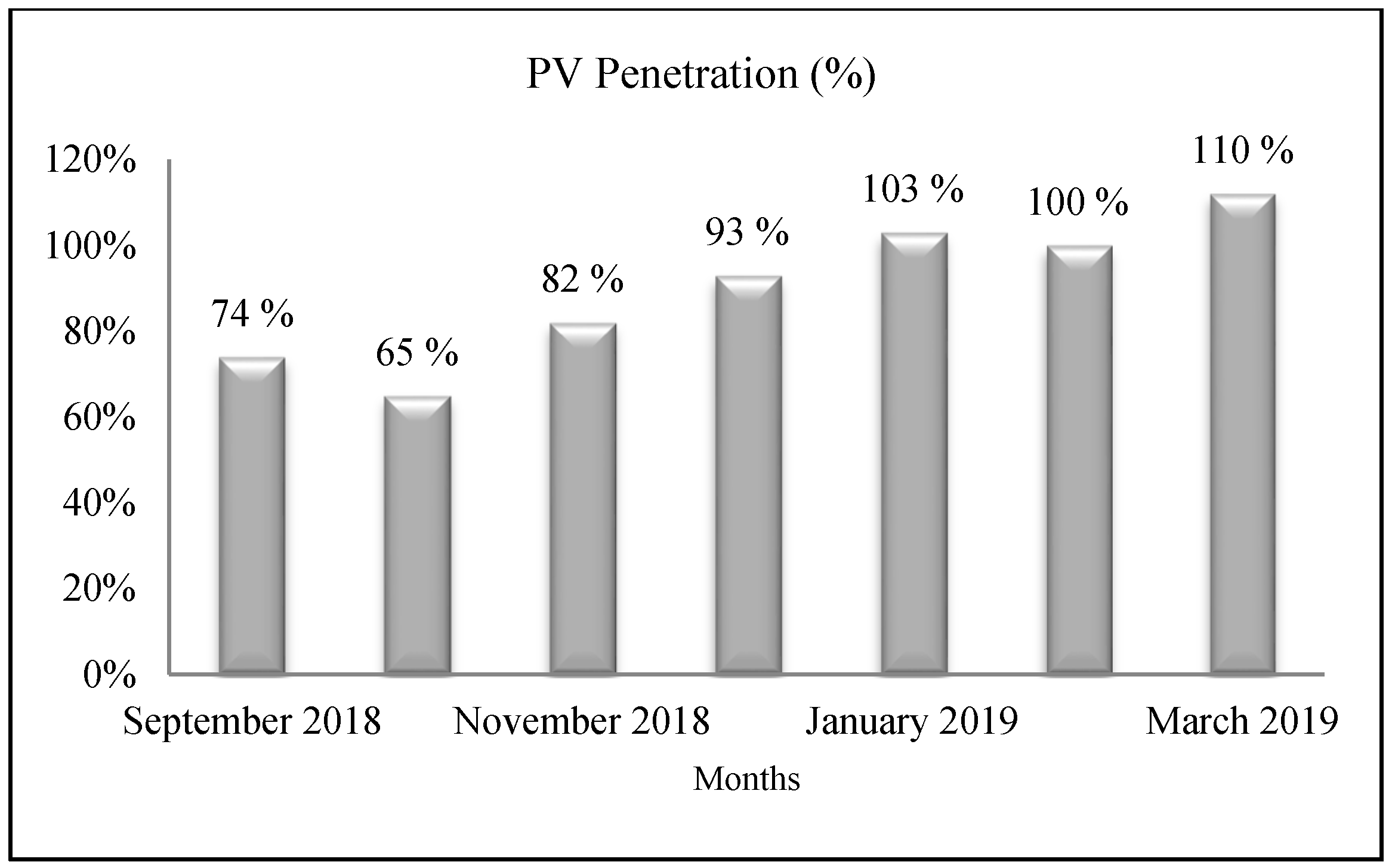
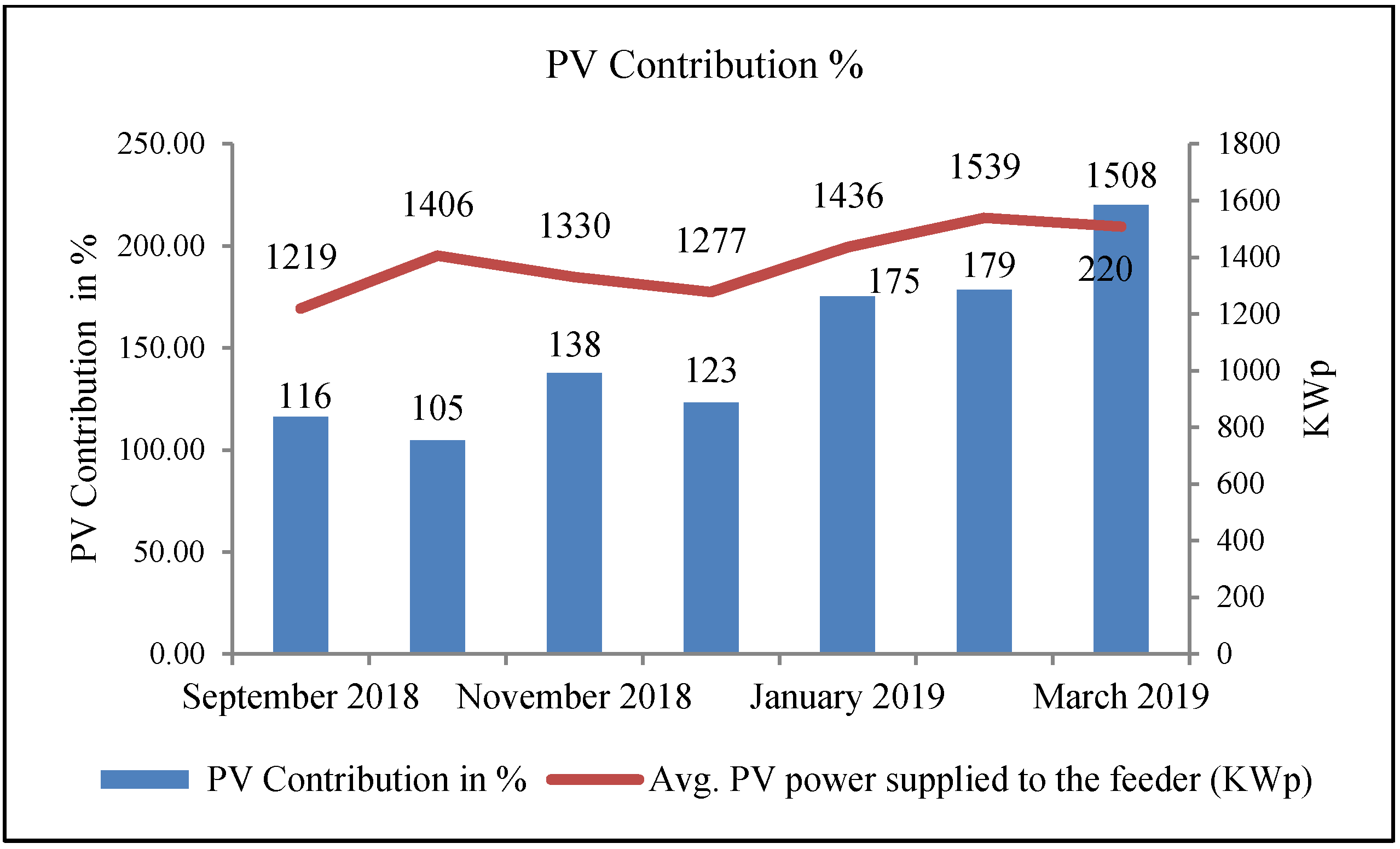

| Project | 2 MW (2.23 MWp) Grid Connected SPV Power Plant |
| Location | Village: Manjarda District: Yavatmal |
| State, Country | Maharashtra, India |
| Geographical Location | 20°15′38″ N, 78°15′21″ E |
| Capacity (AC/DC) | 2 MW/2.23 MWp |
| The technology of PV Modules | Poly Crystalline |
| PV-Modules | 270 Wp |
| Inverters | Tmeic 1000 KW, PVL-L1000E-1 N |
| Inverter Transformer | 2.1 MVA 11 kV/2 × 380 V |
| Auxiliary Transformer | Melcon, 40 kVA, 380/415 V |
| 11 kV Akola Bazar AG | |
| Sub-Station | 33 kV Kolambi |
| Feeder | 11 kV Akola AG (205) |
| Length of Feeder | 95.8 km |
| No of Consumer | 1277 |
| Peak Load | 189 AMP |
| Akola Bazar Gaothan | |
| Sub-Station | 33 kV Kolambi |
| Feeder | 11 kV Akola AG (202) |
| Length of Feeder | 61.2 km |
| No of Consumer | 2902 |
| Peak Load | 90 AMP |
| 11 kV Kolambi Gaothan | |
| Sub-Station | 33 kV Kolambi |
| Feeder | 11 kV Kolambi Gaothan (201) |
| Length of Feeder | 17.5 km |
| No of Consumer | 985 |
| Peak Load | 38 AMP |
| Months | Discrepancies | |||
|---|---|---|---|---|
| Total No. of Breakdown of Feeder | Total Duration of Breakdowns (h) | Total Duration of Load Shedding (h) | Total Generation Lost Hours due to Non-Availability of Supply (h) | |
| September 2018 | 126 | 31:10:00 | 146:50:00 | 200:10:00 |
| October 2018 | 189 | 37:13:00 | 124:00:00 | 161:13:00 |
| November 2018 | 114 | 26:53:00 | 26:50:00 | 53:43:00 |
| December 2018 | 86 | 21:26:00 | 63:37:00 | 85:03:00 |
| January 2019 | 90 | 13:45:00 | 50:26:00 | 64:11:00 |
| February 2019 | 93 | 17:06:00 | 26:04:00 | 43:10:00 |
| March 2019 | 143 | 31:29:00 | 0:00:00 | 31:29:00 |
| Date | November 2018 | December 2018 | January 2019 | February 2019 | March 2019 |
|---|---|---|---|---|---|
| 1 | 29.31 | 7.99 | 19.47 | 30.53 | 25.68 |
| 2 | 18.28 | 7.45 | 21.57 | 28.35 | 31.49 |
| 3 | 15.98 | 6.68 | 24.64 | 30.74 | 28.57 |
| 4 | 4.54 | 8.84 | 26.44 | 22.36 | 13.04 |
| 5 | 9.21 | 9.28 | 25.35 | 24.72 | 24.74 |
| 6 | 17.74 | 9.00 | 16.13 | 26.39 | 31.02 |
| 7 | 17.60 | 13.97 | 26.48 | 21.72 | 32.80 |
| 8 | 22.45 | 14.14 | 32.83 | 13.29 | 32.81 |
| 9 | 23.33 | 7.79 | 28.95 | 26.87 | 29.67 |
| 10 | 14.46 | 1.47 | 33.96 | 18.75 | 32.37 |
| 11 | 15.45 | 6.67 | 21.83 | 29.32 | 31.02 |
| 12 | 15.70 | 8.33 | 25.78 | 31.10 | 32.49 |
| 13 | 14.02 | 4.85 | 31.97 | 31.05 | 29.67 |
| 14 | 15.89 | 10.75 | 16.89 | 31.84 | 32.81 |
| 15 | 10.78 | 7.73 | 30.29 | 35.87 | 29.11 |
| 16 | 13.46 | 0 | 22.58 | 33.96 | 40.00 |
| 17 | 15.22 | 21.53 | 39.33 | 31.11 | 18.33 |
| 18 | 16.28 | 39.59 | 31.21 | 34.56 | 23.03 |
| 19 | 18.03 | 48.09 | 48.60 | 34.05 | 27.71 |
| 20 | 6.45 | 40.94 | 25.18 | 28.69 | 17.33 |
| 21 | 14.13 | 36.67 | 27.07 | 26.70 | 19.39 |
| 22 | 0 | 34.93 | 26.07 | 24.51 | 23.57 |
| 23 | 2.74 | 22.13 | 27.78 | 16.63 | 13.85 |
| 24 | 15.14 | 22.81 | 29.54 | 46.07 | 20.53 |
| 25 | 8.76 | 24.15 | 33.33 | 42.60 | 26.23 |
| 26 | 12.80 | 21.07 | 30.69 | 47.36 | 21.31 |
| 27 | 8.93 | 25.42 | 30.26 | 48.67 | 18.61 |
| 28 | 8.12 | 29.39 | 32.02 | 45.42 | 18.31 |
| 29 | 6.62 | 21.84 | 24.55 | 21.21 | |
| 30 | 11.46 | 37.82 | 32.58 | 21.43 | |
| 31 | 27.45 | 31.64 | 27.42 |
Publisher’s Note: MDPI stays neutral with regard to jurisdictional claims in published maps and institutional affiliations. |
© 2021 by the authors. Licensee MDPI, Basel, Switzerland. This article is an open access article distributed under the terms and conditions of the Creative Commons Attribution (CC BY) license (https://creativecommons.org/licenses/by/4.0/).
Share and Cite
Padole, N.; Moharil, R.; Munshi, A. Performance Investigation Based on Vital Factors of Agricultural Feeder Supported by Solar Photovoltaic Power Plant. Energies 2022, 15, 75. https://doi.org/10.3390/en15010075
Padole N, Moharil R, Munshi A. Performance Investigation Based on Vital Factors of Agricultural Feeder Supported by Solar Photovoltaic Power Plant. Energies. 2022; 15(1):75. https://doi.org/10.3390/en15010075
Chicago/Turabian StylePadole, Nivedita, Ravindra Moharil, and Anuradha Munshi. 2022. "Performance Investigation Based on Vital Factors of Agricultural Feeder Supported by Solar Photovoltaic Power Plant" Energies 15, no. 1: 75. https://doi.org/10.3390/en15010075





